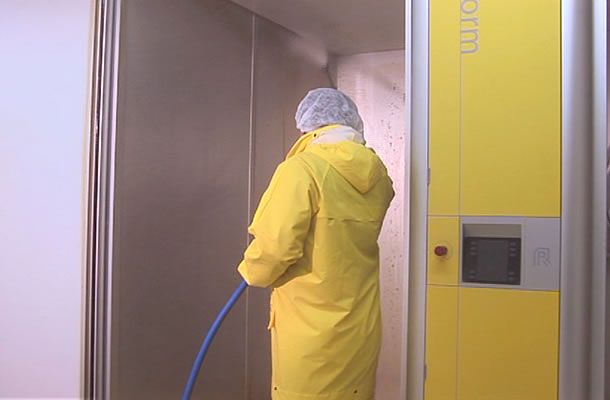Role of cleaning and disinfection
Tags: Hatchery management | Whitepaper
, 27 August 2010

Because of its central position in the poultry production chain, the commercial hatchery has the power both to stop the spread of pathogens, for example from a Salmonella infected breeder flock, or to intensify a disease challenge, by spreading pathogens to customers or other supplying breeder farms.
Poor hygiene leads to reduced hatchability and poor chick quality, and the risk that farmers will lose confidence as a result of increased first week mortality. It is therefore business-critical that commercial hatcheries take hygiene very seriously.
Even with strict biosecurity measures in place, pathogens will inevitably enter the hatchery. Yet two key actions will prevent these pathogens from undermining good hygiene:
- minimising the movement of pathogens within the hatchery from ‘dirty’ (e.g. hatchers, chick processing room) to ‘clean’ areas, by creating hygienic zones, unidirectional product flow, air pressure differences and fluff tunnels
- preventing the further development of pathogens.
We can limit the ability of bacteria and fungi to multiply - for which they require food (proteins, fats, carbohydrates), water, air, and heat, all of which are in plentiful supply in any hatchery environment. Regular cleaning and ensuring that surfaces are dry creates an inhospitable environment for these organisms, which is why smooth surfaces and the avoidance of cracks and crevices are so important. Good cleaning removes up to 85 per cent of micro-organisms - and the remaining 15 per cent can be eradicated by proper disinfection.
Important considerations in the choice of chemicals for cleaning and disinfection are:
- pH values: alkaline soap removes organic dirt (protein, fat) - acid soap removes mineral deposits (such as calcium). Depending on water hardness, the occasional use of acid soap will help maintain smooth surfaces.
- Compatibility: check that the soap does not render the disinfectant ineffective.
- Range of efficacy: broad spectrum disinfectants provide efficacy against a variety of micro-organisms, e.g. Gram-positive and Gram-negative bacteria as well as different viruses and fungi, versus narrow range disinfectant, eg. effective against Gram-negative bacteria only.
- Residual activity, to avoid recontamination.
- Method of application: for example, room disinfection requires gas or fog, while setter disinfection is best achieved with spray.
- Safety for hatchery staff, equipment (corrosiveness) and the environment.
- Pricing: cheaper is not necessarily better. Also consider the concentration required while comparing products.
Commercial disinfectants often contain more than one active ingredient, to complement each other in the fight against a wide variety of pathogens, together with buffering agents, wetting agents, sequestering agents etc. to ensure their efficacy in contact with organic matter, in cold water, in low and high pH and to increase the shelf life.
Advice
- Specify a mandatory schedule of cleaning and disinfection for all rooms, setters and hatchers, equipment, trays, baskets, trolleys.
- Train staff fully, making sure they understand the importance of cleaning and disinfecting all areas properly.
- Always clean thoroughly to remove the majority of micro-organisms before disinfection: remember that ‘dirt’ inactivates disinfectant. The following routine is recommended:
- Remove loose dirt
- Cover whole area with soap and soak for about 15 minutes
- Remove soap together with suspended ‘dirt’.
- Allow to dry properly, as any remaining water will over-dilute disinfectant.
- Apply disinfectant according to the manufacturer’s instructions.
- Discuss your requirements with your supplier to identify the right products for cleaning (soap) and disinfection (disinfectant).
- Take agar cultures or swabs regularly, to monitor the efficacy of cleaning and disinfection procedures.
Written by Gerd de Lange
Senior Poultry Specialist
I welcome your feedback on this article - and if you require any additional information, please don't hesitate to contact me.